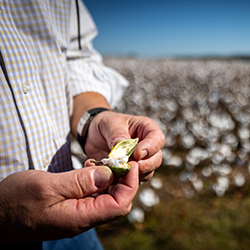This post is part of our blog series entitled “The Journey of Cotton.” This series will focus on the seven unique steps that it takes to process cotton, starting with the planting of the crop to the point it becomes a specific consumer product. We previously discussed cotton ginning, but today’s post will focus on the fourth step in that journey: cotton purification.
The raw cotton arrives in densely packed bales. The bales contain fiber as well as small plant parts and field trash (non-lint or foreign matter). The fiber also has a coating of natural waxes to protect it from rain making it hydrophobic, is water repellent. This makes it unsuitable for use in products that require absorbent clean cotton fibers.
Mechanical Purification Process- Fiber Opening and Cleaning:
The first step in our process is to open the dense tufts of fiber from the bales. The fiber is feed into a hopper that mechanically picks the fiber tufts apart. The opened fiber is feed to a mechanical cleaner or cleaners that continue to open the fiber which this allows the non-lint material to be more easily extracted from the from fibers. The goal is to remove all of the non-lint material but in reality it is never 100% removed.
Wet Purification Process:
This process is conducted in large vessels (kiers). The kiers can be heated and pressurized to speed the process. Cotton is wet out and packed into large cakes with a hole in the middle (think of a Bundt cake). The cakes are then lowered into the kier and it is closed.
Scouring Stage:
 A solution containing sodium hydroxide is pumped into the kier. The kier is heated and pressurized while the alkali solution is continuously pumped through the cakes. During this time the waxes on the fiber are saponified (converted into water soluble soaps) the remaining plant matter is softened, the pectin’s and other non-cellulosic materials are suspended so they can be washed away. After a predetermined length of time at elevated temperature and pressure to allow for the complete scouring, the saponified waxes and suspended materials are rinsed away with fresh water. After scouring the cotton fiber is absorbent and any small amounts of plant matter that remained are softened.
A solution containing sodium hydroxide is pumped into the kier. The kier is heated and pressurized while the alkali solution is continuously pumped through the cakes. During this time the waxes on the fiber are saponified (converted into water soluble soaps) the remaining plant matter is softened, the pectin’s and other non-cellulosic materials are suspended so they can be washed away. After a predetermined length of time at elevated temperature and pressure to allow for the complete scouring, the saponified waxes and suspended materials are rinsed away with fresh water. After scouring the cotton fiber is absorbent and any small amounts of plant matter that remained are softened.
Bleaching Stage:
Note: Although commonly referred to in the industry as “bleaching process” for the cleaning, it in fact is Totally Chlorine Free (TCF) and instead uses very safe hydrogen peroxide as the oxidizing agent instead.
The scouring rinse is drained from the kier and a bleaching solution is pumped into the kier. Barnhardt used only hydrogen peroxide as the oxidizing (bleaching) agent, making our process totally chlorine free, TCF, cotton bleached with peroxide is completely free of dioxins which can be produced with chlorine bleaching agents. The hydrogen peroxide whitens the fibers by oxidizing the coloring matter. Because the remaining plant matter was softened by scouring the bleaching agent can penetrate and oxidize it coloring bodies making them white as well. The bleaching solution is pumped through the cakes for a predetermined time at elevated temperature and time to allow for elimination of the all color bodies. Next the bleaching solution is rinsed away with fresh water and the tank drained. At this point the fiber all of the impurities and coloring bodies have been removed and the cotton fibers are pure cellulose.
Fiber Finishing:
Since the natural fiber finish (waxes) have been removed the fiber can be difficult to process to very high fiber to fiber friction. Therefore to allow for efficient processing on high production web-forming equipment a fiber finish (lubricant) is added. Many types fiber finish can be applied depending on the application. The finish solution is pumped through the cakes allowing the application of the desired level of fiber finish to the cotton fibers. The pH is adjusted down to required pH level using acid. The finish solution is drained. The variety of fiber finishes that we apply to cotton and their functions be covered in the next blog.

Opening and Drying:
The wet cakes are re-opened into tufts of fiber; the fiber is dried to specific moisture levels (determined by customer specifications) and baled. The moisture content of each bale is measured and printed on the bale label that is applied to every Barnhardt bale.
Up Next: Cotton Finishing
This is part four of our seven-part Journey of Cotton series. (If you missed our Introduction, be sure to visit that blog post.) The next step in the cotton journey is Finishing, so keep an eye out on our blog for updates. You can also enter your email address in the “Stay in the Know” field in the right margin to have blog updates sent directly to your inbox.
